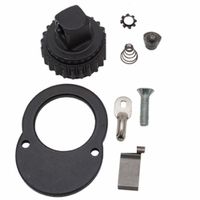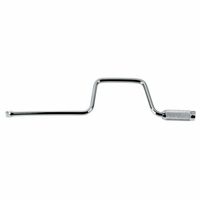Call +(254) 703 030 000 / 751 483 999 / 721 704 777
- Home
- Tools
- Hand Tools
- Ratchets Drive Tools
.....Read More
Frequently Asked Questions
What is the difference between a ratchet and a breaker bar?
A ratchet and a breaker bar are both hand tools used in mechanical applications, but they serve different purposes and have distinct features.
A ratchet is a tool that allows for the tightening or loosening of nuts and bolts with a ratcheting mechanism. It consists of a handle attached to a socket drive, which can be fitted with various socket sizes. The key feature of a ratchet is its ability to turn fasteners in one direction while allowing free movement in the opposite direction, thanks to its internal gear and pawl system. This makes it ideal for working in tight spaces where a full rotation of the handle isn't possible. Ratchets are commonly used for tasks requiring speed and efficiency, and they come in different drive sizes, such as 1/4-inch, 3/8-inch, and 1/2-inch.
A breaker bar, on the other hand, is a non-ratcheting tool designed for applying high torque to loosen stubborn or over-tightened fasteners. It consists of a long, solid metal bar with a socket drive at one end. The extended length of the breaker bar provides greater leverage, making it easier to apply significant force without exerting excessive physical effort. Unlike a ratchet, a breaker bar does not have a ratcheting mechanism, so it requires repositioning after each turn. It is primarily used for breaking loose fasteners that a ratchet cannot handle due to torque limitations.
In summary, the main difference lies in their functions: a ratchet is used for quick and efficient fastening or loosening in confined spaces, while a breaker bar is used for applying high torque to loosen tight fasteners.
How do you maintain and repair a ratchet?
To maintain and repair a ratchet, follow these steps:
1. **Cleaning**: Regularly clean the ratchet to remove dirt and debris. Use a brush or compressed air to clean the gear teeth and other moving parts. Wipe the exterior with a clean cloth.
2. **Lubrication**: Apply a light machine oil or a specialized ratchet lubricant to the moving parts, especially the gear and pawl. This reduces friction and prevents rust. Avoid over-lubricating as it can attract dirt.
3. **Inspection**: Periodically inspect the ratchet for wear and damage. Check the gear teeth, pawl, and handle for any signs of wear or damage. Ensure the ratchet mechanism engages and disengages smoothly.
4. **Tightening**: If the ratchet feels loose, check for any loose screws or bolts and tighten them. Ensure the handle and head are securely attached.
5. **Repairing**: If the ratchet is not functioning properly, disassemble it carefully. Refer to the manufacturer's manual for guidance. Check for worn or broken parts such as the pawl or spring. Replace any damaged components with new ones from a repair kit or the manufacturer.
6. **Reassembly**: After cleaning and replacing any parts, reassemble the ratchet. Ensure all components are aligned correctly and the mechanism operates smoothly.
7. **Storage**: Store the ratchet in a dry place to prevent rust. Use a tool box or case to protect it from dust and moisture.
8. **Usage**: Use the ratchet within its specified limits to avoid overloading and damage. Avoid using it as a hammer or pry bar.
Regular maintenance and prompt repairs will extend the life of your ratchet and ensure reliable performance.
What sizes do ratchet drive tools come in?
Ratchet drive tools, commonly used in mechanical and automotive applications, come in several standard sizes, which refer to the square drive size of the ratchet handle and the corresponding socket. The most common sizes are:
1. **1/4-inch Drive**: This is the smallest standard size, ideal for precision work and tight spaces. It is typically used for small fasteners and light-duty applications, such as electronics or small appliances.
2. **3/8-inch Drive**: A versatile and widely used size, the 3/8-inch drive is suitable for a broad range of tasks, from automotive repairs to general household maintenance. It balances strength and accessibility, making it a popular choice for both professionals and DIY enthusiasts.
3. **1/2-inch Drive**: This size is designed for heavier-duty applications, such as automotive and industrial work. It is commonly used for larger fasteners and provides more torque, making it suitable for tasks that require more force.
4. **3/4-inch Drive**: Less common than the smaller sizes, the 3/4-inch drive is used for heavy-duty industrial applications. It is suitable for large fasteners and high-torque requirements, often found in construction and heavy machinery maintenance.
5. **1-inch Drive**: The largest standard size, the 1-inch drive is used in very heavy-duty applications, such as large machinery and industrial equipment. It is designed to handle the highest torque requirements and the largest fasteners.
These sizes are standardized to ensure compatibility between ratchet handles and sockets, allowing users to interchange tools as needed. Specialty sizes and tools may exist for specific applications, but the above sizes cover the majority of general use cases.
How do you choose the right socket for a ratchet?
To choose the right socket for a ratchet, first determine the size of the fastener you need to work with. Measure the bolt or nut using a caliper or a sizing gauge to ensure accuracy. Next, consider the drive size of your ratchet, which typically comes in 1/4-inch, 3/8-inch, 1/2-inch, and 3/4-inch. Match the socket's drive size to your ratchet's drive size for compatibility.
Select the socket type based on your task. Shallow sockets are suitable for tight spaces, while deep sockets are ideal for reaching recessed fasteners. Consider the socket point configuration: 6-point sockets provide a better grip on hexagonal fasteners, reducing the risk of rounding, while 12-point sockets offer more flexibility in tight spaces.
Material and finish are also important. Chrome vanadium steel is durable and corrosion-resistant, making it a popular choice. Ensure the socket has a polished or chrome-plated finish for added protection against rust.
Finally, consider purchasing a socket set that includes a range of sizes and types to cover various applications. This ensures you have the right socket on hand for different tasks, enhancing efficiency and convenience.
What are the common uses for ratchet accessories?
Ratchet accessories are versatile tools commonly used in various applications across different industries and for personal projects. Here are some of their common uses:
1. **Automotive Repair and Maintenance**: Ratchet accessories, such as socket sets, are essential for loosening and tightening nuts and bolts in vehicles. They are used for tasks like changing tires, working on engines, and assembling or disassembling vehicle parts.
2. **Construction and Carpentry**: In construction, ratchet tools are used for assembling scaffolding, framing, and other structural components. They help in fastening bolts and screws efficiently, ensuring stability and safety.
3. **Plumbing**: Ratchet accessories are used to tighten or loosen pipe fittings and fixtures. They are particularly useful in tight spaces where a standard wrench might not fit.
4. **Bicycle and Motorcycle Maintenance**: Ratchet tools are used for adjusting and repairing bicycles and motorcycles, including tasks like changing wheels, adjusting brakes, and maintaining chains.
5. **Furniture Assembly**: Many flat-pack furniture items require assembly using bolts and screws. Ratchet tools make this process quicker and easier, providing the necessary torque to secure components tightly.
6. **Home Improvement and DIY Projects**: Ratchet accessories are popular in home improvement tasks, such as installing shelves, assembling garden equipment, or repairing household items.
7. **Industrial Applications**: In industrial settings, ratchet tools are used for machinery maintenance, assembly line work, and equipment installation, where precision and efficiency are crucial.
8. **Electrical Work**: Electricians use ratchet tools for installing and maintaining electrical panels, fixtures, and conduits, where precise torque is needed to ensure safety and functionality.
9. **Aerospace and Aviation**: In these industries, ratchet tools are used for assembling and maintaining aircraft components, where precision and reliability are paramount.
Overall, ratchet accessories are indispensable in any toolkit due to their ability to provide leverage, precision, and efficiency in fastening and loosening tasks.
How does a ratchet mechanism work?
A ratchet mechanism is a mechanical device that allows continuous linear or rotary motion in only one direction while preventing motion in the opposite direction. It consists of a gear or wheel with teeth, known as the ratchet, and a pawl, which is a lever or catch that engages the teeth.
As the ratchet wheel turns in the permitted direction, the pawl slides over the sloped edges of the teeth, typically aided by a spring that keeps the pawl engaged with the wheel. When the wheel attempts to move in the opposite direction, the pawl catches against the vertical edge of a tooth, preventing backward motion. This design ensures that the wheel can only rotate or move forward, effectively locking it in place when not in motion.
Ratchet mechanisms are commonly used in tools and devices where controlled motion is necessary, such as in socket wrenches, where they allow the user to tighten or loosen bolts without removing the tool from the fastener. They are also found in clocks, where they help maintain tension in the mainspring, and in various lifting and hoisting equipment, where they prevent loads from slipping back.
The efficiency of a ratchet mechanism depends on the precision of the teeth and pawl design, as well as the material used, which must withstand the forces applied during operation. Variations of the basic ratchet mechanism include multiple pawls for increased load capacity and finer teeth for more precise control.
What are the benefits of using a speed handle or socket driver?
A speed handle or socket driver offers several benefits, particularly in mechanical and automotive applications:
1. **Efficiency**: Speed handles allow for rapid tightening and loosening of fasteners. The crank design enables quick rotation, reducing the time needed compared to using a standard ratchet.
2. **Ease of Use**: The ergonomic design of speed handles provides a comfortable grip, minimizing hand fatigue during extended use. This is particularly beneficial in repetitive tasks.
3. **Precision**: Speed handles offer better control over the torque applied to fasteners, reducing the risk of over-tightening or stripping threads. This precision is crucial in delicate assemblies.
4. **Versatility**: They can accommodate various socket sizes and types, making them suitable for a wide range of applications. This versatility reduces the need for multiple tools.
5. **Accessibility**: The design allows for use in tight or confined spaces where a standard ratchet might not fit. This makes them ideal for engine bays or other cramped environments.
6. **Durability**: Typically made from high-quality materials, speed handles are robust and can withstand significant wear and tear, ensuring a long service life.
7. **Cost-Effective**: By reducing the time and effort required for tasks, speed handles can increase productivity, leading to cost savings in labor-intensive environments.
8. **Safety**: The controlled application of force reduces the likelihood of tool slippage, which can prevent accidents and injuries.
9. **Portability**: Lightweight and compact, speed handles are easy to transport and store, making them convenient for both professional mechanics and DIY enthusiasts.
Overall, speed handles and socket drivers enhance productivity, precision, and safety, making them valuable tools in any toolkit.



